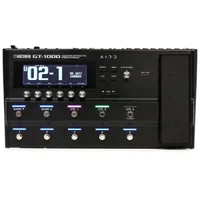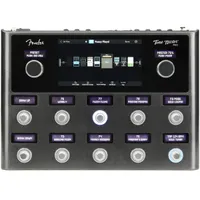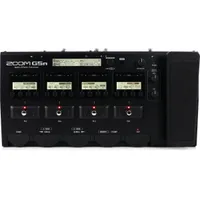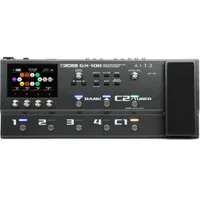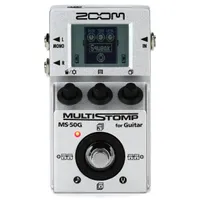Best multi-effects pedals 2025: Our pick of the best all-in-one guitar FX modellers
Our guide to the best multi-effects pedals will help you get your head around amp modelling pedals and multi-FX
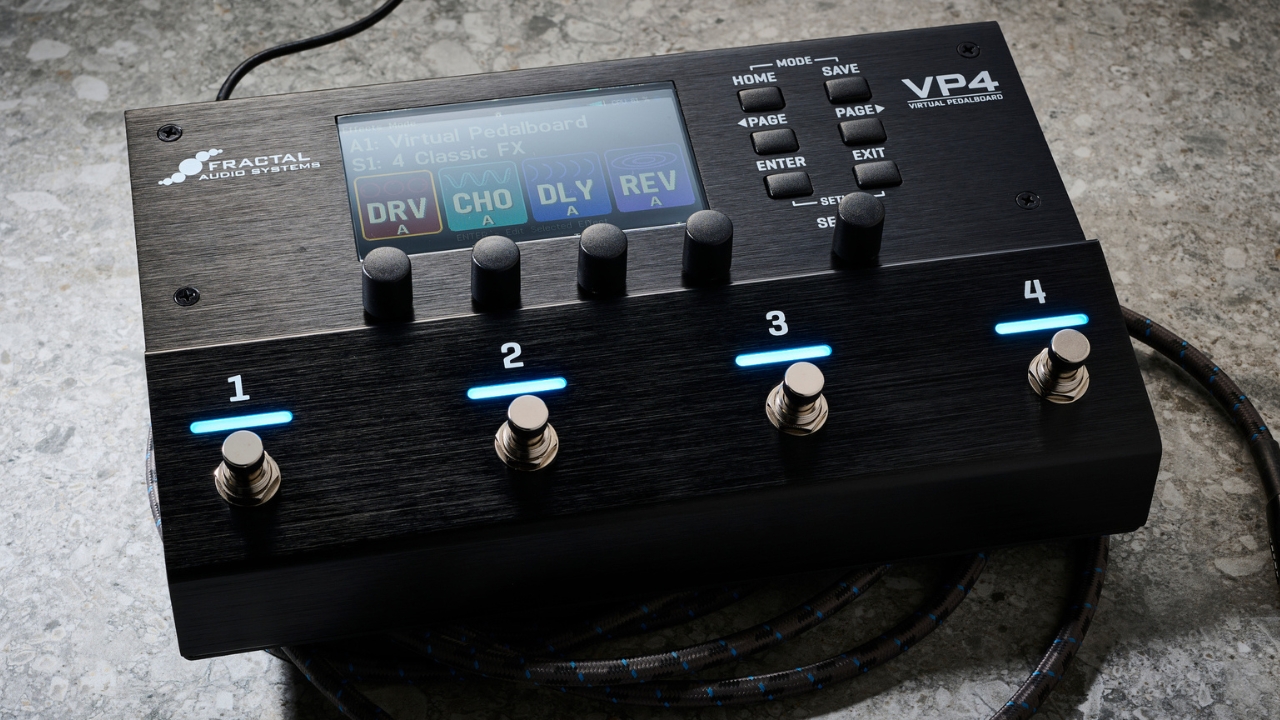
Looking for the best multi-effects pedal you can buy in 2024? Well, you're in the right place. Not only do I regularly use a multi-FX on my pedalboard when gigging and recording, but I've also reviewed 8 multi-effects pedals in the past year alone. My selection of multi-faceted stompboxes will have you covered whether you're looking to augment an existing rig or replace yours entirely.
As guitarists, we're absolutely spoiled for choice when it comes to effects pedals nowadays, and the definition of multi-effects has shifted hugely in the past ten years. When I first started playing my Zoom 606 would simply simulate a pedalboard, whereas nowadays modern multi-effects can perform amp and cab duties alongside scarily accurate recreations of the world's most famous stompboxes.
Personally, I still like to use a tube amp as part of my rig, and I use my multi-effects to cover all my time-based and modulation effects without having to carry so many pedals around. If you want your multi-effects to replace your entire rig you can do that too, but I would recommend getting an FRFR speaker for monitoring if you're playing live.
Below you'll find my handpicked selection of the best multi-effects pedals money can buy, sorted by use case to make your choice a little easier. Every single choice bar one has a review (I'm working on rectifying that), so you can dive deeper into whichever unit takes your fancy. If you want to lean on my 20 years of multi-effects playing experience, then check out the FAQs section which features loads of common questions answered by an expert.
My top picks

With a frankly colossal amount of amps, cabs, effects, presets, the ability to load your own IRs, and outstanding connectivity, for me, it doesn't get much better than the Line 6 Helix.
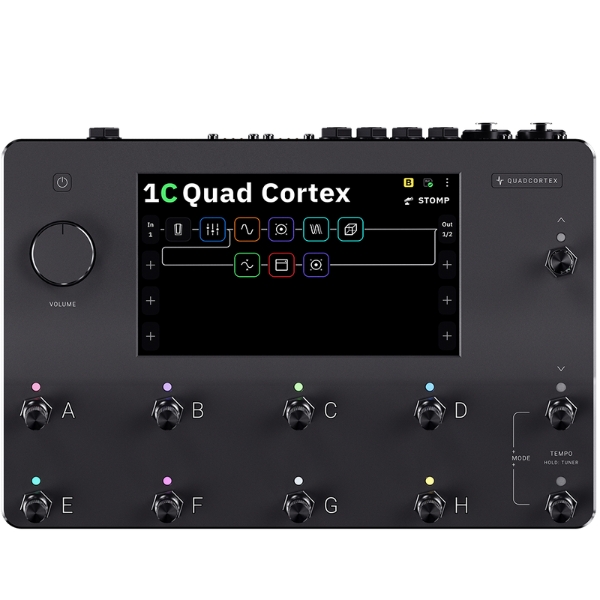
With it's huge amount of processing power, the Neural DSP Quad Cortex is one of the best in the game when it comes to accurately emulating the world's most famous amplifiers.

The Kemper Profiler Stage is the choice of many a professional guitarist when it comes to ampless touring setups, and it allows you to capture your own amp tones with ease.
Best overall

Specifications
Reasons to buy
Reasons to avoid
✅ Buy if you want a multi-effects all-rounder: With its huge amp selection and massive range of effects models, the Helix is our pick as the best overall multi-effects you can buy.
❌ Avoid if you like things simple: With so much choice and connectivity, this isn't one for those who suffer from option paralysis.
The dual-DSP-powered Helix combines amp and effects models in a large, rugged floor pedal. You'll find a not inconsiderable 1,024 presets loaded onto the Helix, split into eight setlists with 32 banks and four presets each. Each preset can have up to four stereo signal paths, each made up of eight blocks populated with amps and effects.
If it's sound creation you're after, then you have an absolute bounty of options to play with - the line-up includes 41 modelled amps, seven bass amps, 30 cabs, 16 microphones, 80 effects and the option to load up speaker impulse responses. Line 6 has implemented an easy editing system, complete with a joystick, and - get this - touch-sensitive footswitches offering a shortcut to parameter adjustment; you can even use these with your feet to select a parameter before adjusting it with the pedal treadle!
There are some great sounds here, especially when we got beyond the factory presets and shaped things to our own tastes. The Helix's advantage lies in its comprehensive input/output and signal routing ability, which can facilitate just about any guitar-related studio or onstage task you can think of. However, if you don't need all that connectivity, and want to save a bit of cash, there's also the Line 6 Helix LT which features further down this list.

"Helix's efforts have an increased level of both accuracy of sound and playability, and will react to the nuances of your playing style - these are sounds that can stand side by side with Kemper or Fractal models."
Read more: Line 6 Helix review
Best amp models
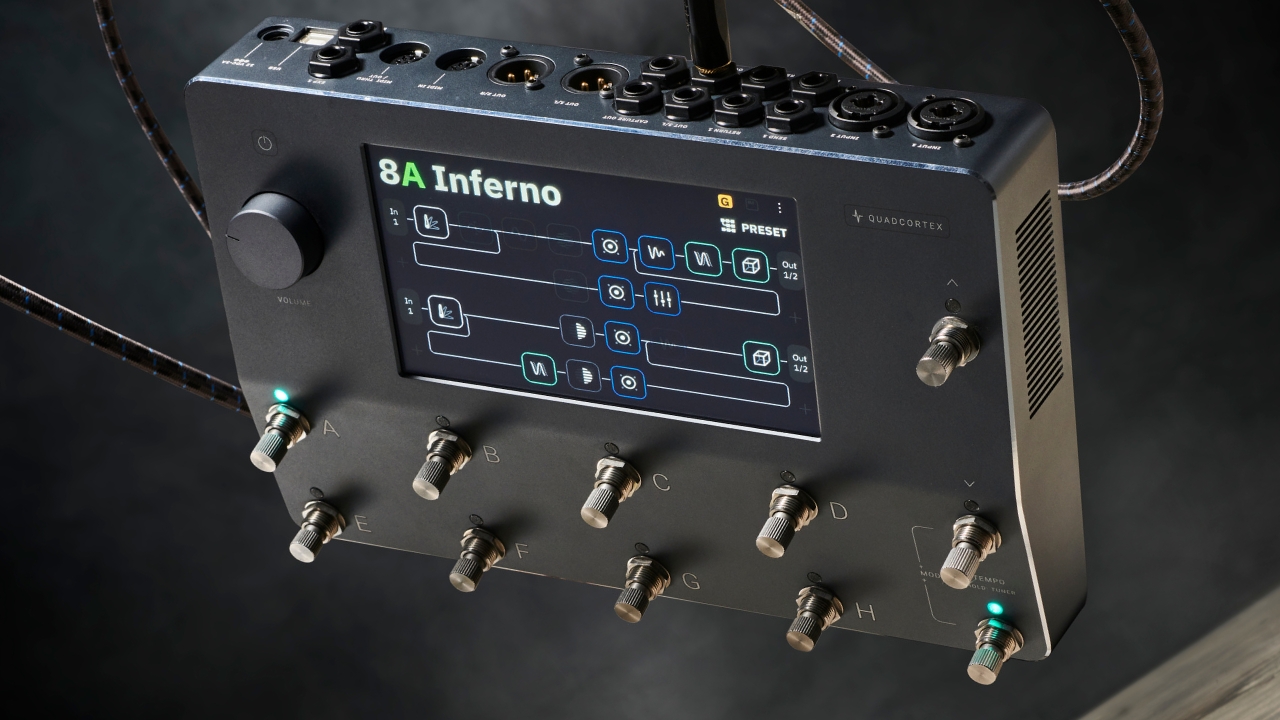
Specifications
Reasons to buy
Reasons to avoid
✅ Buy if you want a pro-level multi-effects pedal: The amp models on the QC are simply unparalleled, making it a great choice for the player who wants a lot of choice and flexibility.
❌ Avoid if you're on a budget: This kind of tech doesn't come cheap, so avoid this if your budget is tight.
Harnessing the power of 2GHz Quad-Core SHARC DSP, the Neural DSP Quad Cortex is a supremely powerful tool for the pro guitar player. It’s not cheap, but there’s a reason many pro-guitar players are switching to this brilliant amp modeler slash profiler.
The processing power of the QC means that the quality of the effects and amp models is simply jaw-dropping. In a blind test we doubt many guitarists could tell the difference between the QC and the real deal, and when you add in the ability to model your own gear - you’ve got little reason not to make the switch to modeling.
The unit itself is compact yet extremely rugged, and we absolutely love the clever footswitch/rotary control hybrids, allowing the QC to stay smaller than the vast majority of competing amp modelers. Just imagine, all of your amps, cabs, and effects pedals in a unit no bigger than a laptop. Simply incredible stuff.

"The quality of the sounds is exceptional. That processing power is really brought to bear on the signal path. Even the most complex rigs are rendered with superb fidelity, and with the promise that more is to come, it suddenly begins to look like money well spent."
Read more: Neural DSP Quad Cortex review
Best profiler
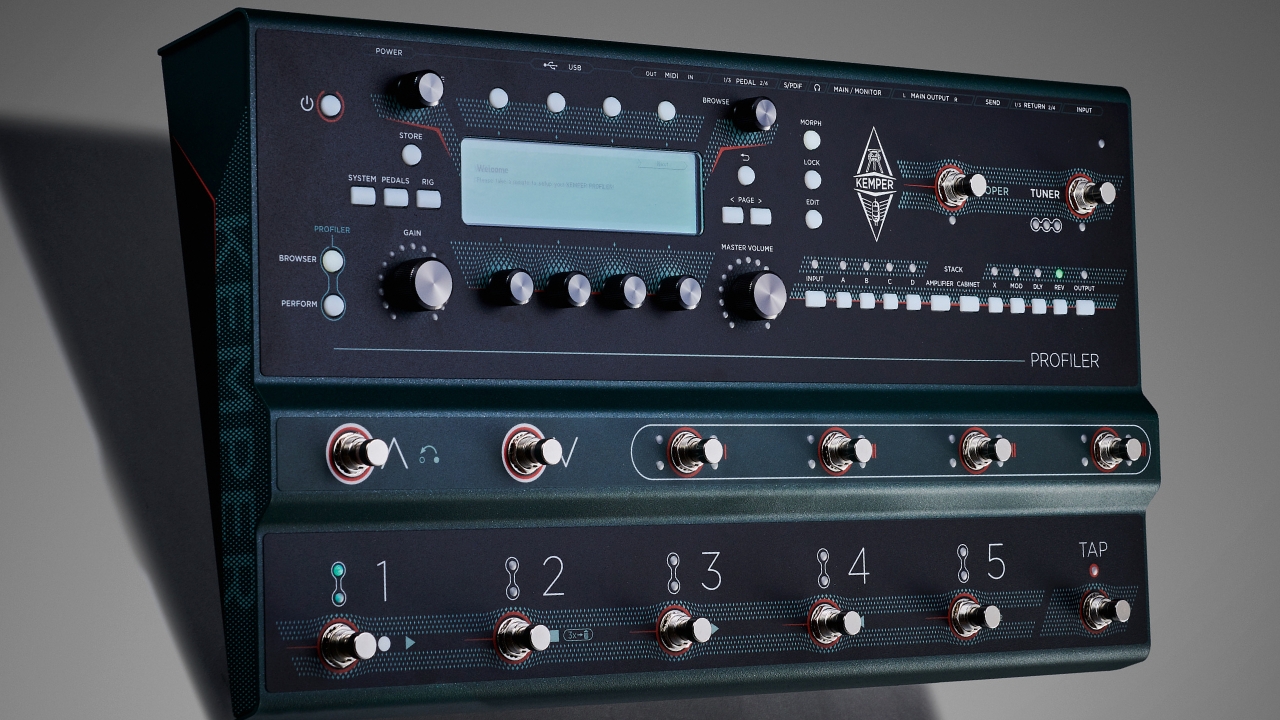
Specifications
Reasons to buy
Reasons to avoid
✅ Buy if you want a pro-level profiler: The Kemper allows you to make models of your own amps and effects, making it a powerful choice for taking your regular rig on the road minus the weight and transport costs.
❌ Avoid if you're not tech-savvy: Operating the Kemper will require some proper manual diving, so not one for those who like their pedals simple to use.
The Kemper Profiler Stage is way more than just a multi-effects pedal. It replaces your rig entirely, giving you every amp and effect combination you could ever dream of. Coming in a handy pedalboard format, this powerful profiler could well be the last guitar purchase you ever make.
Pre-loaded with some of the finest amp models and effects ever made, everything here has been profiled in professional recording studios, ensuring you get the best sound possible. There are distortions, delays, choruses, and pretty much any other effect you can think of, all easily edited with Kemper’s Rig Manager app.
The unit itself is sturdily built, giving you plenty of reassurance that it will put up with a hectic touring schedule. A built-in looper and tuner offer extra functionality and you can plug in up to four expression pedals to modulate any parameter you like. Add in the wealth of connections on the back and you’ve got one of the most complete multi-effects pedals out there.

"I love this Kemper’s tonal quality and the Stage offers the class-leading sounds I’d expect. Alongside the user-profiling capability and vast array of online profiles on offer, the Kemper Stage proves to be worth the investment for players who want access to a wealth of great and versatile guitar sounds."
Read more: Kemper Profiler Stage review
Best budget option

4. Mooer GE200 Multi-Effects Pedal
Our expert review:
Specifications
Reasons to buy
Reasons to avoid
✅ Buy if you're on a tight budget: The Mooer GE200 is a fantastic option for players on a tight budget, giving you a lot of great sounds and functionality for relatively little.
❌ Avoid if you're regularly gigging: This isn't quite as rugged as some of the other units on this list, so probably not best for players who are regularly travelling with their multi-effects.
The Chinese brand Mooer has slowly but surely built itself a reputation for hitting the sweet spot between price and performance. What began as a brand offering low-cost versions of existing big-name pedals has grown to them now being considered a genuine contender in the low-to-mid range.
The Mooer GE200 is a great example, offering a selection of effects, models and tools that wouldn't look (or sound) out of place on a unit far higher up the effects food chain. The 70 included effects all sound great, and we particularly liked the ability to load your own impulse responses to fine-tune your speaker outputs. Very capable, and definitely worth your attention.
Best for live performance
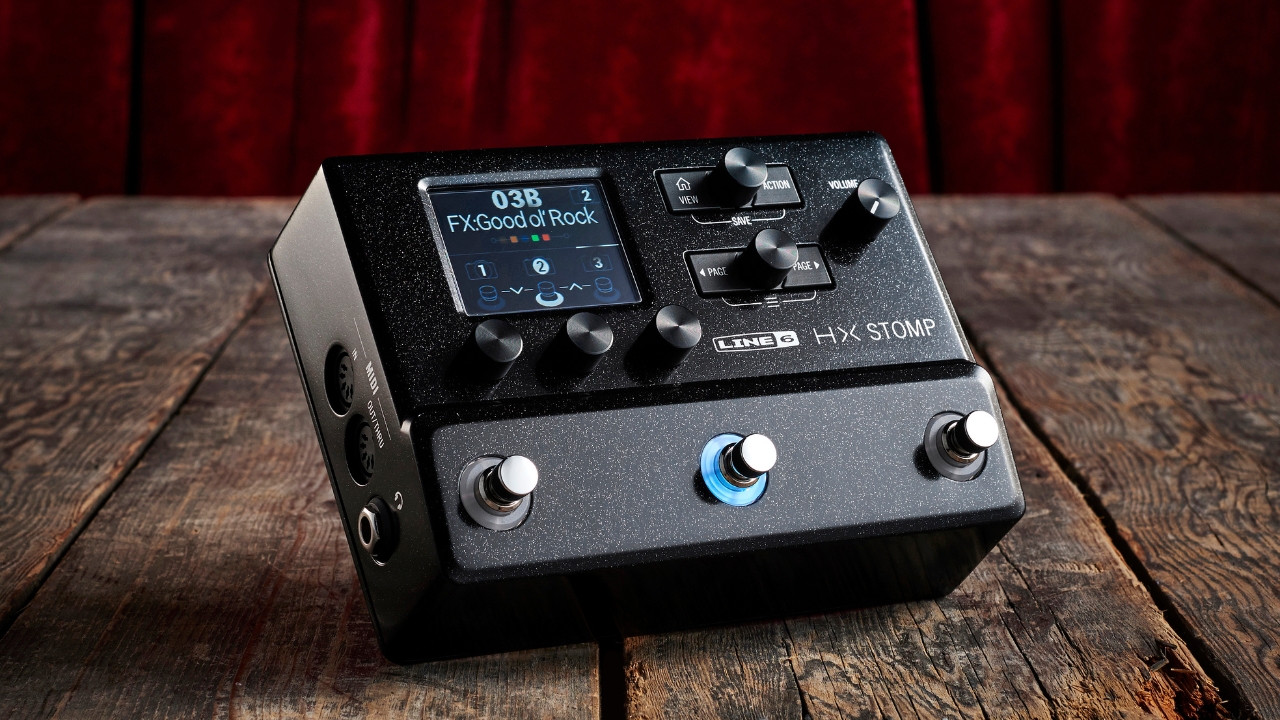
Specifications
Reasons to buy
Reasons to avoid
✅ Buy if you're regularly playing live: With its small size, excellent amp selection, and fantastic connectivity, the HX Stomp is perfect for strapping onto a pedalboard and taking out on the road.
❌ Avoid if you don't like menu diving: It's a small screen with very few buttons, so you'll have to remember combinations to get the best out of it without the HX Edit app.
The HX Stomp contains over 190 effects, including the Helix, M Series and legacy Line 6 patches, as well as the amp, cab and mic options of the full-fat Helix. It supports loading of impulse responses, too, so if you've modelled your own amps, or purchased commercial IRs from somewhere else, they can be loaded into the pedal too.
Cramming not only the sounds of those units, but also a full-colour screen into a unit the size of the HX Stomp is certainly impressive and no mean feat. With MIDI in and out, there’s clearly been some consideration for those that want to incorporate the HX Stomp into a rig controlled by a pedal switcher. In that context, it’s easy to see the attraction.
Though the HX Stomp is limited in terms of its controls on the front, it’s highly customisable, and offers a broad palette of professional-grade effects to explore. For the guitarist that wants specific modulations, delays or a cab sim on tap ‘just in case,’ the HX Stomp is a smart, compact solution, and the capacitive footswitches make assigning and editing a relatively error-free procedure - it’s unlikely you’ll need to refer to the manual much at all. And if you don't need the amp models and fancy a few more footswitches, there's also the HX Effects.

"For the guitarist that wants specific modulations, delays or a cab sim on tap ‘just in case,’ the HX Stomp is a smart, compact solution, and the capacitive footswitches make assigning and editing a relatively error-free procedure - it’s unlikely you’ll need to refer to the manual much at all."
Read more: Line 6 HX Stomp review
Best creative option

Specifications
Reasons to buy
Reasons to avoid
✅ Buy if you want more 'out-there' effects: The H90 has some properly wacky effects that are perfect for guitar players of the experimental variety.
❌ Avoid if you need amp modelling: The H90 only does effects, there's no amp modelling here so not an option for replacing your full rig.
The Eventide H90 Harmonizer is the follow-up to the cult classic Eventide H9, of which many could be found on pro guitarists’ pedalboards. Loads of guitarists were adding two H9s to their ‘boards to make the most out of the amazing algorithms on board, so it made sense for the next iteration that Eventide would essentially stick two H9s together in one unit.
The H90 does an amazing job of marrying your more run-of-the-mill delays and reverbs with some of the weirder pitch-shifting effects to make something that’s perfect for the sonic explorers. If you feel like you’ve tried every effect out there and nothing is quite cutting it for you, then this powerful bit of kit might be the perfect choice.
There’s an incredible array of routing options for integrating it into your rig, and you can select which effects you want to run before or after your amplifier for extra flexibility. As well as being an incredibly powerful tool for guitarists, it’s also right at home in the studio thanks to its excellent editing app.
Read the full Eventide H90 Harmonizer review

"You’ll find some algorithms work better in certain situations than others, but that’s just the tip of the iceberg, and finding out is half the fun. The amount of options here is staggering and certainly adds to the value of a pedal, which let’s face it, is probably not on a lot of people’s shopping lists due to its lofty price. However, it blows its smaller brother out of the water in every way, so we feel the price tag is more than justified."
Read more: Eventide H90 Harmonizer review
Best for beginners
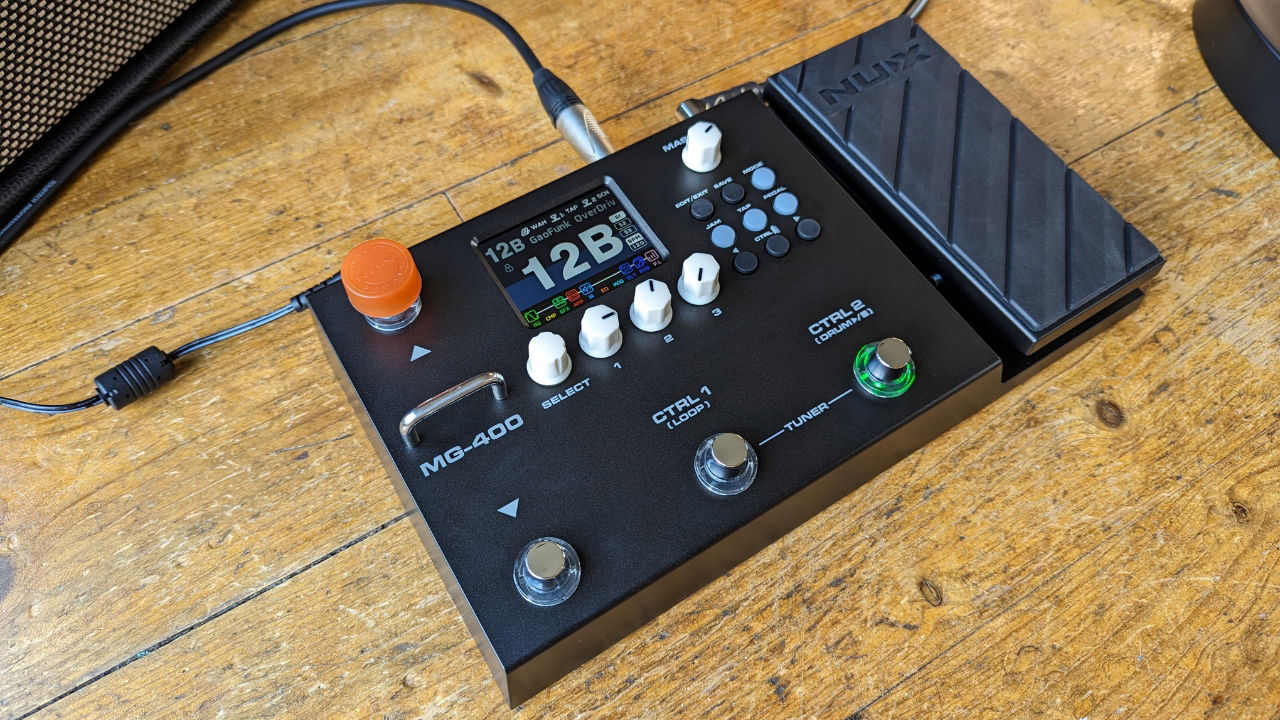
Specifications
Reasons to buy
Reasons to avoid
✅ Buy if you're a first-timer: With its low cost and superb selection of amps and effects, the MG-400 is a great option for beginner guitar players who want their first multi-effects.
❌ Avoid if you don't like tweaking: To get the best out of it you'll want to tweak the tones from the presets, so avoid if you want straight out-of-the-box usability.
If you've been following the rise of NUX, then you'll know they pride themselves on making everything from amplifiers to electronic drum kits accessible to everyone - and that extends to multi-effects units.
The newly released MG-400 is their latest pedal, and frankly, it may be their best unit yet. This value-packed modeller builds on what NUX established with the MG-300 and is powered by their flagship White-Box Amp Modeling algorithm.
Better yet, the new MG-400 introduces scene functionality which allows you to set up "snapshots" within a preset, for easy recall of multiple effects - perfect for gigging guitar players! For us, the NUX MG-400 is an insanely powerful multi-effects unit that certainly outperforms its price range.

"Once I’d tweaked things I managed to get some properly nice clean tones with plenty of ambience offered via the reverbs and delays. There’s a nice shimmer reverb and the panned delay effect is really fun, especially with a pair of headphones on."
Read more: NUX MG-400 review
Best compact option
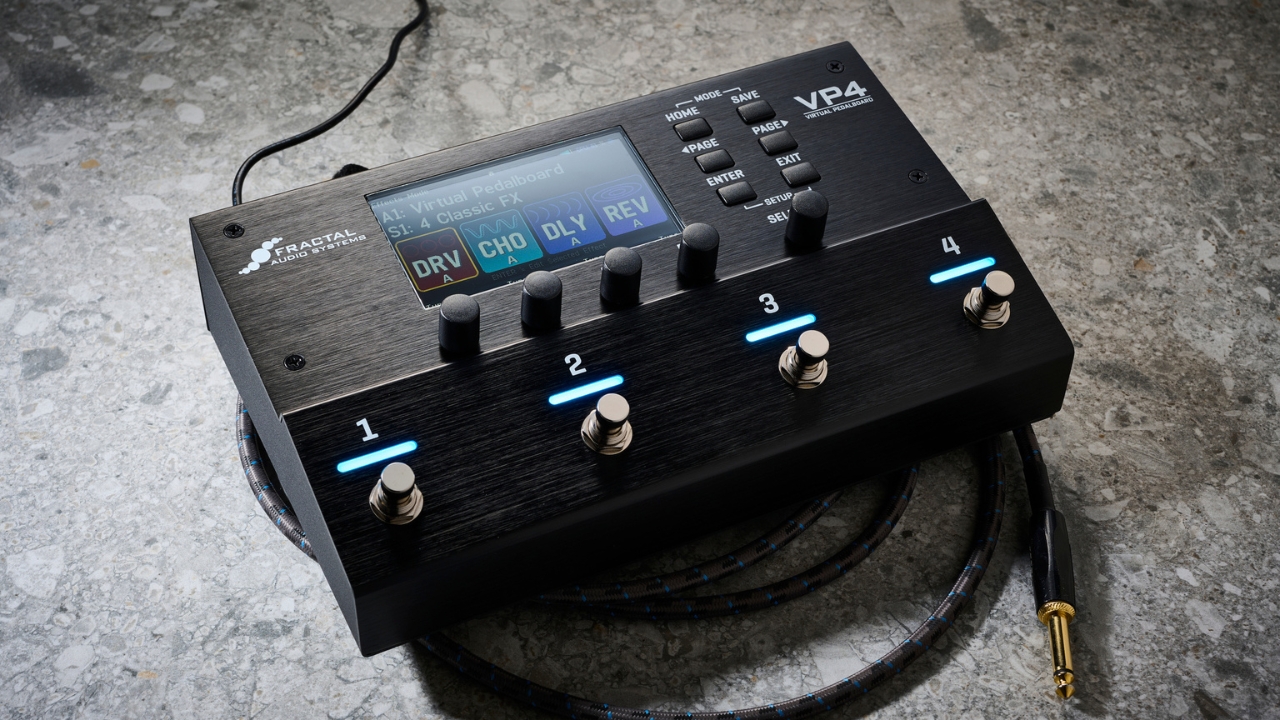
Specifications
Reasons to buy
Reasons to avoid
✅ Buy if you want to add to a pedalboard: Covering a huge range of drives, delays, reverbs, and modulation effects, the VP4 is a great choice if you just want to add more effects to your pedalboard for live playing.
❌ Avoid if you need more than four effects at once: Limited to four effects at the same time, if you're the experimental sort of player this might not provide enough for your needs.
Doing away with the amp sims, the Fractal VP4 Virtual Pedalboard is a true multi-effects pedal that allows you to add effects to your pedalboard without the faff of amp modeling and impulse responses. Coming in a rock-solid housing, this is a gig-worthy pedalboard addition that could be perfect for those gigging guitarists who want to save on real estate.
The VP-4 passed the 'no manual' test with flying colours, allowing us to easily start chaining together effects without any deeper diving or Googling. Of course, it does have editing software for deeper effects tweaking that's similarly easy to use. One thing we really loved was the micro guitar tuner that's always on screen. Too small for stage use granted, but great when you're practicing at home or recording in the studio.
The delays and reverbs are absolutely stunning, the definition of studio-grade quality in our opinion. There are plenty of classic tones accounted for here alongside some more esoteric sounds like granular delays and filter sweeps. The drives are equally good quality, sounding very much like the real thing when you place them in front of a guitar amp.

"The range of high-quality effects crammed into the VP-4 means that it can be used to experiment, as well as cover specific pedals missing on a board. I found it worked best when run with a distortion pedal and pitch-shifter in front, but it could viably replace an entire board, drives and all."
Read more: Fractal Audio VP4 Virtual Pedalboard review
Best for bass
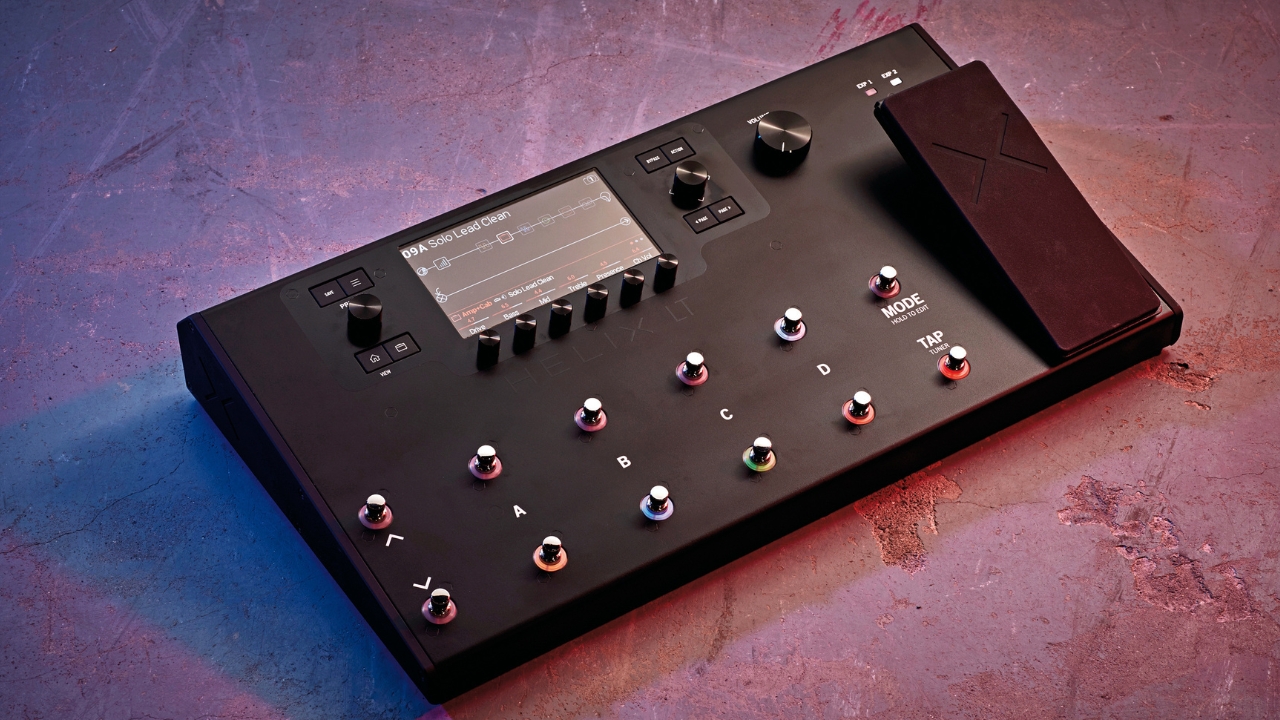
Specifications
Reasons to buy
Reasons to avoid
✅ Buy if you want a multi-effects pedal for bass: With a huge selection of some of the best bass amps in the world, the Helix LT is a great option for bass (and guitar) players.
❌ Avoid if you need something compact: This pedal is pretty large, so one to avoid if you need something you can just chuck into a backpack.
There are not that many dedicated multi-effects pedals for bass guitar players and while the Line 6 Helix LT is primarily aimed at guitarists, it also features an excellent selection of bass amp models for four and five-string players.
There are 17 different bass amp models, with official Ampeg models as they're a sub-brand of Yamaha Guitars. You also get some fantastic models based on Fender, Mesa/Boogie, Galien-Kreuger, Orange, and Aguilar amps, plenty to satisfy even the most tone-hungry bassist.
Add in more effects than we could count, and you've got a superbly versatile bass rig. With plenty of octave effects for super low rumbling tones, synth sounds when you're feeling more esoteric, envelope filters, delays, chorus, and many other modulation effects, you can generate pretty much any tone you think of with the Helix LT.

"Okay, so the LT may have lost some of the functionality of its bigger, more expensive sibling, but it still has the exact same sound and easy operation, which includes quick and intuitive editing directly from the front panel or the computer-based software editor. Would you miss some of those original functions? Well, for most users, probably not: there’s very little expunged that makes the LT less potent for live use, that is unless the two extra send and returns and a third expression pedal are a deal-breaker for you."
Read more: Line 6 Helix LT review
Spec comparison
Here you'll find a side-by-side comparison of each of the multi-effects pedals in this guide to help you narrow down your decision further.
Model | Amps | FX | Custom IRs | Inputs | Outputs | MIDI |
|---|---|---|---|---|---|---|
Line 6 Helix | 72 | 192 | 128 | 3 | 5 | Yes |
Neural DSP Quad Cortex | 90 | 70 | 256 | 2 | 4 | Yes |
Kemper Profiler Stage | 300 | 136 | Unlimited | 2 | 8 | Yes |
Mooer GE200 | 55 | 70 | 26 | 1 | 2 | No |
Line 6 HX Stomp | 72 | 192 | 128 | 2 | 2 | Yes |
Eventide H90 | N/A | 62 | N/A | 4 | 4 | Yes |
NUX MG-400 | 25 | 48 | 512 | 1 | 2 | No |
Fractal Audio VP4 | N/A | 300 | N/A | 2 | 2 | Yes |
Line 6 Helix LT | 72 | 192 | 128 | 1 | 4 | Yes |
Also consider
The multi-effects pedals listed above are the ones we reckon you should spend your cash on, but if you didn't find what you were looking for, we've reviewed loads more here.
Boss GT-1000
16 amp models | 116 effects
After the success of the 500 series units, Boss's GT-1000 floorboard combines all three. Sleek and modern, it's a formidably robust beast. To the rear, there’s the usual array of inputs and outputs, including USB recording out and an input for an additional expression pedal.
★★★★½
Read more: Boss GT-1000 review
Fender Tone Master Pro
27 amp models | 82 effects
Fender’s modeling offering is a versatile one, with their signature glassy clean present and accounted for as well as plenty more on offer. From British-style amp voicings to the higher gain tones of the EVH series you won’t be shy of sounds to choose from here.
★★★★½
Read more: Fender Tone Master Pro review
Zoom G5n
10 amp models | 68 effects
Packing in 68 digital effects, 10 amp and cabinet emulators, and a stereo looper with up to 80 seconds of looping time, the Zoom G5n is a worthy option for beginners or anyone looking to expand their options.
★★★★
Read more: Zoom G5n review
Boss GX-100
23 amp models | 150 effects
Coming in at around half the price of the flagship GT-1000, the Boss GX-100 certainly doesn’t offer half the performance. This is a professional-level multi-effects, with an intermediate price tag. This sleek and stylish unit houses an impressive 23 amp models and 150 effects.
★★★★½
Read more: Boss GX-100 review
Zoom MS-50G MultiStomp
22 amp models | 100+ effects
Following a raft of recent updates, the MS-50G now boasts over 100 effects and 22 amp models, six of which can be used simultaneously in any order. Add a chromatic tuner into the equation, and you're looking at a pedal for all seasons.
★★★★
Read more: Zoom MS-50G MultiStomp review
How to choose

When it comes to picking the right multi-effects pedal, you've got loads of options to explore. Your budget will ultimately steer your choice, but you'll find everything from large "studio-in-a-box" setups to compact pedals that have just the essentials for your board. Here are a few things to think about.
First off, what do you actually want from a pedal? Are you on a quest for the ultimate overdrive or reverb to nail that perfect sound? Maybe you’re more of an explorer, keen to try out all sorts of effects from phasers to harmony features. If that’s you, look for a pedal that offers plenty of variety. Most multi-effects units cover the classics like delay and chorus but some also throw in quirky effects like pitch shifters and loopers. The trick is to choose one that matches your sound goals.
Next, think about how easy it is to use. You don’t want to wrestle with it like it’s a complicated puzzle! Some pedals come with straightforward layouts and easy-to-read screens, while others might require a manual just to figure out how to switch them on. If you prefer just plugging in and playing, go for one with clearly marked knobs and dedicated switches. But, if you love diving into settings and tweaking everything to perfection, a more complex pedal could be just what you need.
Keep in mind the quality of the effects too. Not every effect is a winner, and some budget-friendly options might throw in a few less-than-great presets. So, it’s worth checking out reviews and user opinions. Watching online demos can help you hear how the pedal sounds in action.
Size and portability matter as well. If you’re gigging regularly, you won’t want to lug around a giant pedalboard. Some multi-effects pedals are nice and compact, easily slipping into your gig bag, while others are more suitcase-sized. Think about how often you’ll be moving your gear around.
Connectivity is another key factor. Make sure the pedal has the inputs and outputs you need. Are you linking it up to an amp, a computer, or even running it through an audio interface for recordings? Some pedals come with handy extras like MIDI or USB connections, which can be a big help if you plan to integrate with your DAW.
Last but not least, set a budget! There are some great options out there at every price point, so decide what you can realistically spend before diving in. While it’s tempting to go for the priciest model, don’t ignore the hidden gems that offer fantastic value for money.
Glossary
- Digital Signal Processor (DSP): This is the chip inside the pedal that processes audio signals to create effects, enabling cool sound manipulations.
- Display: It’s a visual screen, usually LCD or LED, that shows info like settings, selected effects, and signal levels.
- Effects Chain: This refers to the order in which effects are connected and processed in the pedal. You can change this order to make different sounds.
- Expression: An expression pedal allows real-time control over effect settings such as wah or even volume.
- Footswitch: A switch you operate with your foot to turn effects on and off or change settings while performing.
- I/O (Input/Output): These are the connectors on the pedal for plugging in your guitar and sending the output to amplifiers or other devices, usually including ¼” jacks and sometimes MIDI or USB connections.
- Pedalboard: A flat platform where you can mount your pedals for easy access and tidy organisation during gigs.
- Presets: These are pre-set configurations for different effects, making it easy to switch between sounds quickly.
- Routing: This gives you the flexibility to decide how the signals flow through the effects chain, allowing for either serial or parallel processing.
- Sample Rate: This is the number of audio samples taken per second, affecting the quality of the digital audio processing in the pedal.
- Tap Tempo: A function that lets you set the tempo for effects like delay or modulation by tapping a footswitch in time with the beat you want.
- True Bypass: This feature allows the signal to skip the effect circuit when the pedal’s off, keeping the original tone of your guitar intact.
FAQs

What should I look for in a multi-effects pedal?
If there's one thing you've got when choosing the best multi-effects pedal for you, it's a wide selection. As with anything, your allocated budget will dictate which end of the spectrum you'll end up at, but there’s plenty of choice, from enormous 'studio-in-a-box' type units, to small form-factor pedals that pack a handful of essential effects onto your pedalboard. Here are some things to consider.
How many effects is too many?
We've all seen examples of someone firing up a multi-effects unit, blasting through the presets like a kid in a sweetshop, but it’s crucially important to consider the types of effects you'll actually use.
Be realistic with yourself, because it’s likely you’ll settle on a small handful of the best guitar effects. Would you be better served looking for a smaller, more capable unit to handle the effects you use the most? Or do you absolutely need the spaceship-looking behemoth full of wacky sounds?
The alternative theory is that, occasionally, you can stumble on something you've never used before and it can spark your creativity. This definitely happens, and is a happy side benefit of having so many effects at your beck and call. For a beginner, the sub-$200 range has plenty to get you excited.
If packing in as many effects as you can into a single box is your aim, you'll find plenty of options to choose from at all ends of the price scale. From budget options like the smaller Zoom pedals, through to entry-level versions of the pro models from the big names in effects like Boss and Line 6.
What do I get if I spend a bit more?
As you move up the range, you'll start to see extra features and functionality like loopers, hardened chassis models and extra connectivity. It's not uncommon now for multi-effects to link with apps on your smart device, where you can get in for deep editing of parameters and settings.
Also common nowadays is for a multi-effects unit to double up as an audio interface or amp modeller. These USB-enabled devices can be plugged into one of the best laptops for music production, allowing you to record songs into a digital audio workstation (DAW) like Ableton Live or Pro Tools.
As ever though, our advice is simple. Work out what you'll realistically want, need or use. Be clear on your budget. Don't be distracted by extra bells and whistles - unless that’s what you want.
Are multi-effects pedals worth it?
It all depends on what you value when it comes to guitar. There are many guitarists who prefer a traditional pedalboard layout. You can tweak each pedal individually without menu diving, reorder them at will, or replace them whenever you feel like something isn’t working.
However with a multi-effects unit, you’ve got less chance of failure due to bad patch cables or faulty pedalboard power supplies, less to carry around, and they’re usually cheaper when you take into account the cost of some individual pedals.
In terms of pure value for money, we’d argue that yes, multi-effects pedals are worth the investment. You get much more bang for your buck with a multi-effects pedal, at the expense of some ease of use.
Why trust us?
☑️ Established 2007
☑️ 2.9 million monthly users globally
☑️ 9,500+ reviews on-site
With more than 17 years of experience, MusicRadar is the premier music-making website in the world. Run by musicians for musicians, we offer expertly written gear round-ups and high-quality, authoritative reviews by an extensive team of highly experienced industry professionals.
Below you'll find more information on the expert authors of this guide.

Matt is a Junior Deals Writer here at MusicRadar. He regularly tests and reviews music gear with a focus on audio interfaces, studio headphones, studio monitors, and pretty much anything else home recording-related. Responsible for over 60 buying guides, a large part of his role is helping musicians find the best deals on gear. Matt worked in music retail for 5 years at Dawsons Music and Northwest Guitars and has written for various music sites including Guitar World, Guitar Player, Guitar.com, Ultimate Guitar, and Thomann’s t.blog.
A regularly gigging guitarist with over 20 years of experience playing live and producing bands, he's performed everything from jazz to djent, gigging all over the UK in more dingy venues than you can shake a drop-tuned guitar at. He's an alumnus of Spirit Studios, where he studied studio engineering and music production.

I'm a Senior Deals Writer at MusicRadar, and I'm responsible for writing and maintaining buyer's guides on the site - but that's not all I do. As part of my role, I also scour the internet for the best deals I can find on gear and get hands-on with the products for reviews. My gear reviews have been published in prominent publications, including Total Guitar, Guitarist, and Future Music magazine, as well as Guitar World.com. I've also had the privilege of interviewing everyone from Slash to Yungblud, as well as members of Sum 41, Foo Fighters, The Offspring, Feeder, Fever 333, and many more.
I have a massive passion for anything that makes a sound, particularly guitars, pianos, and recording equipment. In a previous life, I worked in music retail, giving advice on all aspects of music creation and selling everything from digital pianos to electric guitars, entire PA systems, and ukuleles. I'm also a fully qualified sound engineer who holds a first-class Bachelor's degree in Creative Sound Production from the University of Abertay, and I have plenty of experience working in various venues around Scotland.
How do we test a multi-effects pedal?

Testing out a multi-effects pedal is a fairly straightforward procedure, and similar to testing a standalone stompbox. Although the quality of pedals is subjective - like many pieces of musical equipment - there is a set of criteria that every pedal should meet before we recommend it to anyone.
We'll first start with the build quality of the enclosure, controls and footswitch. Pedals are designed to be stood on, so we need to ensure that the enclosure and footswitch feel robust, solid and able to withstand being stamped on. We then check the quality of the dials, making sure that they have a smooth action with enough resistance to reduce accidental movement.
We also check to see how well spaced out and easy to use the footswitches are. We'll also check the expression pedal if there is one, and make note of its action and usability. Multi-effects pedals are here to make your lives easier, after all.
We then test the pedals sonically, and much like our amp testing procedures, we start with every dial in the middle '12 o'clock' position. We then tweak each dial towards a tone we would usually go for - and make sure that we experiment with the full range of sounds on offer. We'll then check any amp or effect emulations or presets. We'll cycle through those, while editing a few as we go to see how easy the process is (or isn't).
Read more about how we test music making gear and services at MusicRadar.
Related buyer's guides
MusicRadar's got your back
- The best distortion pedals for every budget
- The best looper pedals you can buy right now
- The best guitar plugins to supercharge your guitar recordings
- Take a look at some of the best gifts for guitarists
- The best pedalboard power supplies
- On a tight budget? Here are the best cheap guitar pedals
Want all the hottest music and gear news, reviews, deals, features and more, direct to your inbox? Sign up here.

Matt is a Junior Deals Writer here at MusicRadar. He regularly tests and reviews music gear with a focus on audio interfaces, studio headphones, studio monitors, and pretty much anything else recording-related. Matt worked in music retail for 5 years at Dawsons Music and Northwest Guitars and has written for various music sites including Guitar World, Guitar Player, Guitar.com, Ultimate Guitar, and Thomann’s t.blog. A regularly gigging guitarist with over 20 years of experience playing live and producing bands, he's also an alumnus of Spirit Studios, where he studied studio engineering and music production.
- Daryl RobertsonSenior Deals Writer
